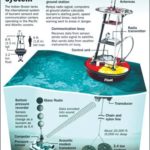Geo-Informatics
Scientists use satellites to detect deep-ocean whirlpools
 Using sensor data from several U.S. and European satellites, researchers from the University of Delaware (UD), NASA’s Jet Propulsion Laboratory and the Ocean University of China have developed a method to detect super-salty, submerged eddies called “Meddies” that occur in the Atlantic Ocean off Spain and Portugal at depths of more than a half mile. These warm, deep-water whirlpools, part of the ocean’s complex circulatory system, help drive the ocean currents that moderate Earth’s climate. This research has enabled the scientists to detect phenomena so deep in the ocean from space, using a new multi-sensor technique that can track changes in ocean salinity. The research was supported by grants from the NASA, the Office of Naval Research and the NOAA.
Using sensor data from several U.S. and European satellites, researchers from the University of Delaware (UD), NASA’s Jet Propulsion Laboratory and the Ocean University of China have developed a method to detect super-salty, submerged eddies called “Meddies” that occur in the Atlantic Ocean off Spain and Portugal at depths of more than a half mile. These warm, deep-water whirlpools, part of the ocean’s complex circulatory system, help drive the ocean currents that moderate Earth’s climate. This research has enabled the scientists to detect phenomena so deep in the ocean from space, using a new multi-sensor technique that can track changes in ocean salinity. The research was supported by grants from the NASA, the Office of Naval Research and the NOAA.
First identified in 1978, Meddies are so named because they are eddies – rotating pools of water – that flow out of the Mediterranean Sea. A typical Meddy averages about 2,000 feet (600 meters) deep and 60 miles (100 kilometers) in diameter, and contains more than a billion tons (1,000 billion kilograms) of salt. Coupling data collected by several different satellite-borne sensors, researchers from the University of Delaware, NASA’s Jet Propulsion Laboratory, and the Ocean University of China have been able to “break through” the ocean’s surface to detect “Meddies” — super-salty warm-water eddies that originate in the Mediterranean Sea and then sink more than a half-mile underwater in the Atlantic Ocean.
China unveils land observation satellite launch plan
 China will launch 18 land observation satellites in the next ten years, China Center for Resources Satellite Data & Application (CRESDA) announced on March 17. According to CRESDA, the Sino-Brazil earth resource satellite 02B will be launched in 2007 and its data will be released for free. In addition, the overall development plan for satellite 03, 04 has been approved by the State Council. The 18 satellites made up of land resource and environmental series, together with the marine and meteorological ones, will help China build up an earth observation system for long- term stable operation. To make sure the full use of satellite data, CRESDA undertakes the task for building China’s land satellite system, which includes data processing, data and information collection, payload management, data simulation and analysis, data distribution and demonstration.
China will launch 18 land observation satellites in the next ten years, China Center for Resources Satellite Data & Application (CRESDA) announced on March 17. According to CRESDA, the Sino-Brazil earth resource satellite 02B will be launched in 2007 and its data will be released for free. In addition, the overall development plan for satellite 03, 04 has been approved by the State Council. The 18 satellites made up of land resource and environmental series, together with the marine and meteorological ones, will help China build up an earth observation system for long- term stable operation. To make sure the full use of satellite data, CRESDA undertakes the task for building China’s land satellite system, which includes data processing, data and information collection, payload management, data simulation and analysis, data distribution and demonstration.

KMC to develop satellite map for Kolkata
Kolkata Municipal Corporation (KMC) in the Indian city of Kolkata will shortly develop a unique satellite map of the entire city of Kolkata. It will provide the entire satellite mapping of the city, which gives a satellite mapping of the entire world. Kolkata will be one of the first Indian cities to have its own unique satellite map. The satellite map, developed through picture taken either through satellite or from the air, has been developed by Riddhi Communications and Netguru India has been assigned the task of maintaining the site. A GIS model has been utilised in preparing the satellite map of the city.

The satellite map will be a virtual map of the entire city and will have details of the tourist destinations, hotels and lodges, among other things and will also give graphical description of how to go from one place to another. The map will also have a number of important information for Kolkata citizens. Kolkatans will now have detailed information about KMC-run health centres in the city, as well as information on whether there had been any particular disease that is on the rise in any particular ward. The map will also have details on schools and educational institutions, NGOs, the city’s transport system and other relevant details.
Singapore completes first phase of Tsunami Warning System
 Singapore announced the completion of the first phase of its Tsunami Early Warning System on March 23. Phase one of the system provides Singapore with the capability to exchange real-time earthquake data with seismic networks operated by countries in the region. Developed by the Meteorological Services Division of the NEA, the system worth 3 million Singapore dollars is expected to be completed by the end of 2007.
Singapore announced the completion of the first phase of its Tsunami Early Warning System on March 23. Phase one of the system provides Singapore with the capability to exchange real-time earthquake data with seismic networks operated by countries in the region. Developed by the Meteorological Services Division of the NEA, the system worth 3 million Singapore dollars is expected to be completed by the end of 2007.
Be a part of Elets Collaborative Initiatives. Join Us for Upcoming Events and explore business opportunities. Like us on Facebook , connect with us on LinkedIn and follow us on Twitter, Instagram.











